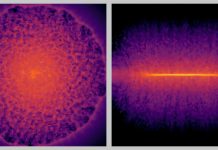
For years, scientists have been intrigued by a mysterious signal coming from the icy south pole of Mars.
In 2018, a radar instrument called MARSIS, aboard a European Mars orbiter, detected a very bright reflection from deep beneath the planet’s southern polar ice cap.
The reflection came from an area about 20 kilometers wide and was interpreted by some researchers as a possible underground lake of liquid water — a discovery that would be hugely important for the search for life on Mars.
However, Mars today is extremely cold and dry. Liquid water cannot easily exist on its surface, and even deep under the ice, it would need special conditions to stay in a liquid state.
It would likely have to be an ultra-salty brine or be warmed by underground volcanic heat.
Because of this, some scientists have argued that the bright radar signal might not be caused by water at all, but instead by unusual layers of ice, frozen carbon dioxide, salty minerals, or certain types of rock that reflect radar strongly.
To investigate further, scientists turned to a second radar instrument called SHARAD, which is onboard NASA’s Mars Reconnaissance Orbiter. SHARAD works at higher frequencies than MARSIS, but for a long time it was not powerful enough to send signals deep enough through the ice to reach the area where the bright zone was detected.
This meant direct comparison between the two radar systems was difficult.
Recently, however, the Mars Reconnaissance Orbiter team tested a new and unusual maneuver. Instead of making its usual small roll adjustments, the spacecraft was rotated by a large angle of 120 degrees in space. This “very large roll,” or VLR, allowed SHARAD to send a stronger signal into the ice and reach greater depths than before.
Using this new technique, a team led by Gareth Morgan examined 91 different SHARAD radar scans that passed over the same high-reflectivity area identified by MARSIS.
Only when the new VLR maneuver was used did SHARAD detect any echo from the base of the ice at that location. Even then, the signal was very weak, much weaker than what would be expected from a large body of liquid water.
This faint reflection suggests that the bright MARSIS signal is probably not caused by a lake of liquid water. Instead, the researchers think it may be the result of a smooth, flat area of ground under the ice that happens to reflect radar waves strongly.
Certain types of frozen materials or specific surface shapes beneath the ice could also help explain the signal without requiring liquid water.
The study, published in Geophysical Research Letters, does not completely rule out the presence of liquid water under Mars’ ice cap.
Instead, it adds an important new piece of evidence that makes liquid water less likely in this particular location. The researchers emphasize that more studies will be needed to fully understand why the two radar instruments see the area differently.
While this may disappoint some who hoped Mars was hiding a secret underground lake, it also shows how science moves forward. By using new tools and creative techniques, researchers are slowly uncovering a more accurate picture of the Red Planet — one careful measurement at a time.



